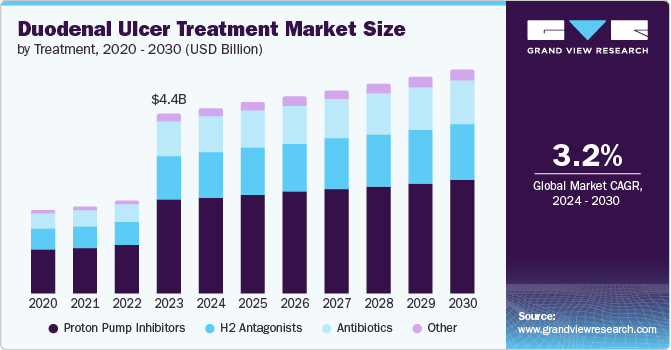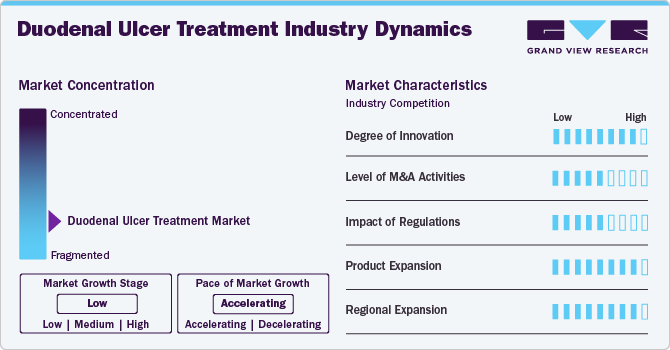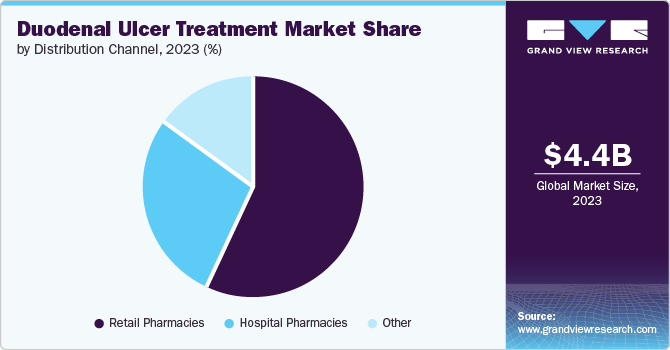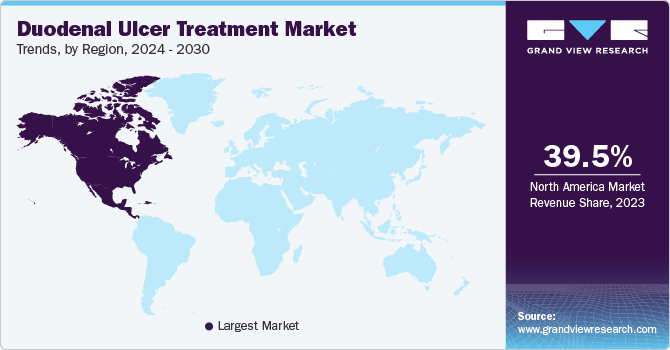- Home
- »
- Pharmaceuticals
- »
-
Duodenal Ulcer Treatment Market Size & Share Report, 2030GVR Report cover
![Duodenal Ulcer Treatment Market Size, Share & Trends Report]()
Duodenal Ulcer Treatment Market Size, Share & Trends Analysis Report By Treatment (Proton Pump Inhibitors, H2 Antagonists), By Route Of Administration (Oral, Parenteral), By Distribution Channel (Retail Pharmacies), By Region, And Segment Forecasts, 2024 - 2030
- Report ID: GVR-4-68040-446-2
- Number of Report Pages: 90
- Format: PDF, Horizon Databook
- Historical Range: 2018 - 2023
- Forecast Period: 2024 - 2030
- Industry: Healthcare
Duodenal Ulcer Treatment Market Trends
The global duodenal ulcer treatment market size was estimated at USD 4.45 billion in 2023 and is projected to grow at a CAGR of 3.18% from 2024 to 2030. The market is driven by a combination of factors, including the rising prevalence of duodenal ulcers, advancements in treatment options, increasing awareness and diagnosis rates, and the growing adoption of personalized medicine. These elements collectively enhance the demand for effective therapeutic interventions and contribute to market expansion. According to the National Centre for Biotechnology Information (NCBI), approximately 5-10% of people worldwide suffer from peptic ulcers, including duodenal ulcers

Recent innovations in pharmaceuticals and medical technologies have led to more effective treatments for duodenal ulcers. New drug formulations, including proton pump inhibitors (PPIs) and H2-receptor antagonists, showed improved efficacy in managing symptoms and promoting healing. A report indicates that PPIs are now considered first-line therapy for peptic ulcer disease due to their effectiveness in reducing gastric acid secretion.
Advancements in treatment options are a key driver of the duodenal ulcer treatment market, significantly enhancing therapeutic efficacy and patient outcomes. Recent developments include the introduction of novel proton pump inhibitors (PPIs) and combination therapies that provide superior acid suppression and faster healing compared to older treatments. According to an article published in December 2023, advancements such as extended-release formulations and dual-therapy regimens address specific patient needs, improving adherence and reducing recurrence rates. These innovations and ongoing research and development efforts drive increased demand for advanced treatment options and fuel market growth.
Market Concentration and Characteristics
The degree of innovation in the duodenal ulcer treatment market is high, characterized by development of new therapeutic options and advanced diagnostic technologies. According to the NCBI, introducing potassium-competitive acid blockers (P-CABs) and novel antibiotic regimens specifically targeting Helicobacter pylori infections is crucial for effective treatment. Additionally, integrating digital health solutions, such as telemedicine and mobile health applications, enhances patient management and monitoring.
The level of merger and acquisition (M&A) activities in the duodenal ulcer treatment market is medium, as pharmaceutical companies seek to expand their portfolios and enhance their capabilities in managing gastrointestinal disorders. Recent examples include larger firms acquiring smaller biotech companies specializing in innovative peptic ulcer therapies. This trend facilitates the sharing of resources and expertise and accelerates the development of new treatment options, ultimately benefiting patients.

The impact of regulations on the duodenal ulcer treatment market is medium, as regulatory bodies play a crucial role in ensuring the safety and efficacy of new treatments. The approval process for novel therapies can be lengthy, potentially delaying the availability of beneficial medications for patients. However, initiatives by regulatory agencies to expedite the approval of treatments for gastrointestinal disorders have positively influenced the market. For instance, the U.S. Food and Drug Administration (FDA) implemented programs to fast-track the development of drugs that address unmet medical needs, encouraging innovation and investment in the duodenal ulcer treatment landscape.
Product expansion in the market is high, with pharmaceutical companies actively pursuing the development of new medications and therapies. The increasing prevalence of duodenal ulcers and the rising awareness of effective treatment options led to a growing pipeline of investigational drugs, including combination therapies that integrate PPIs and antibiotics. Launches of new formulations and delivery methods, such as extended-release tablets, also enhance the treatment landscape.
Region expansion is high as companies increasingly focus on emerging markets to reach a broader patient population. Regions such as Asia-Pacific and Latin America are becoming key areas of interest due to rising awareness of gastrointestinal health and improving healthcare infrastructure. Partnerships with local healthcare providers and investments in regional clinical trials facilitate the entry of new therapies into these markets. As a result, expanding into diverse regions is expected to enhance access to innovative treatments for duodenal ulcers, ultimately benefiting patients worldwide.
Treatment Insights
The proton pump inhibitors (PPIs) segment held the largest revenue share of 52.3% in 2023 due to their effectiveness and widespread use in managing acid-related disorders. PPIs, such as omeprazole, lansoprazole, and pantoprazole, work by irreversibly inhibiting the H+/K+ ATPase enzyme in gastric parietal cells, significantly reducing gastric acid secretion. This mechanism alleviates symptoms and promotes faster healing of duodenal ulcers. Additionally, the increasing prevalence of duodenal ulcers, often associated with Helicobacter pylori infections, drives the demand for PPIs as part of combination therapy regimens to eradicate the bacteria.
The antibiotics segment experienced the fastest-growing CAGR, primarily due to the increasing prevalence of Helicobacter pylori infections, a significant cause of duodenal ulcers. Rising awareness about effective treatment options and the growing number of clinical studies supporting antibiotic therapies drive this growth. Additionally, advancements in antibiotic formulations and combination therapies have improved patient outcomes, further propelling demand. Introducing new antibiotics and combination regimens that enhance eradication rates of H. pylori, are key factors contributing to this trend.
Route Of Administration Insights
The oral segment held the largest revenue share of 78.4% in 2023 due to its convenience, ease of administration, and patient compliance. Oral medications, such as proton pump inhibitors (PPIs) and H2-receptor antagonists, are preferred by both patients and healthcare providers as they can be easily self-administered at home without requiring injections or hospital visits. Additionally, the growing prevalence of duodenal ulcers and increasing awareness about gastrointestinal health drive demand for effective oral therapies. Instances of successful treatment outcomes with oral medications further bolster their market dominance.
Moreover, this segment is experiencing the fastest CAGR over the forecast period, driven by advancements in drug formulations and increased research focused on developing more effective oral therapies. Innovations such as extended-release formulations and combination therapies improve treatment outcomes and patient adherence rates. Instances of successful marketing campaigns by pharmaceutical companies that emphasize the benefits of oral treatments also play a crucial role in driving growth within this segment. As healthcare systems prioritize cost-effective solutions, oral medications are likely remain a preferred choice for patients and providers.
Distribution Channel Insights
The retail pharmacies segment held the largest revenue share of 57.45% in 2023 due to widespread accessibility, patient convenience, and a growing prevalence of gastrointestinal disorders. Retail pharmacies are the first point of contact for patients seeking over-the-counter medications and prescriptions, which enhances their role in managing duodenal ulcers. Additionally, these pharmacies' promotional activities and patient education initiatives increase awareness and treatment regimen adherence. Instances such as partnerships between pharmaceutical companies and retail chains for exclusive product launches further bolster this segment's revenue.

The other market segment is experiencing the fastest CAGR due to the increasing adoption of alternative therapies and rise in online pharmacies that provide easy access to medications. Additionally, the growing awareness of duodenal ulcers and their treatment options among patients has increased demand for non-traditional treatment methods. Instances such as telemedicine consultations and direct-to-consumer marketing strategies have also contributed significantly to this growth, allowing patients to explore diverse treatment avenues beyond conventional healthcare settings.
Regional Insights
The duodenal ulcer treatment market in North America dominated the market and accounted for a revenue share of 39.54% in 2023 and is experiencing substantial growth driven by continuous innovation and extensive healthcare infrastructure. Innovations include the development of novel drug formulations and delivery systems aimed at improving patient compliance and treatment efficacy. Regulatory bodies such as the FDA are increasingly focused on expediting the approval process for new treatments through initiatives such as the Breakthrough Therapy designation.

U.S. Blastic Duodenal Ulcer Treatment Market Trends
The U.S. duodenal ulcer treatment market is characterized by a high adoption rate of novel therapies and a strong emphasis on personalized medicine. Recent statistics from the National Institutes of Health show customized treatment regimens, including targeted therapies based on genetic profiles. Launching new PPIs and innovative drug delivery systems further drives market growth, while strategic partnerships and mergers, such as the recent collaboration between biotech firms and large pharmaceutical companies, are expanding treatment options.
Europe Duodenal Ulcer Treatment Market Trends
The duodenal ulcer treatment market in Europe is witnessing a rise in combination therapies for duodenal ulcers, driven by increasing awareness of antibiotic resistance and the need for more effective treatment regimens. Countries such as France focus on clinical guidelines emphasizing early diagnosis and intervention. The European Medicines Agency (EMA) is proactive in approving new therapeutic agents, which led to a surge in available treatment options.
The UK duodenal ulcer treatment market is influenced by the National Health Service's (NHS) focus on cost-effective and innovative treatments. Launching new generic PPIs and biosimilars has been a major trend, driven by the NHS's push for affordable healthcare solutions. Recent data from the National Institute for Health and Care Excellence (NICE) indicates the use of these cost-effective alternatives, reflecting their growing importance in the treatment landscape.
The duodenal ulcer treatment market in France is characterized by a focus on innovative therapies and strategic collaborations. France has a well-established healthcare system that supports the development and adoption of new treatments. The country witnessed an increase in the number of patients suffering from peptic ulcers, which is fueling the demand for effective treatments. These factors and the growing awareness among healthcare professionals and patients drive the market's growth.
Asia Pacific Duodenal Ulcer Treatment Market Trends
The Asia Pacific duodenal ulcer treatment market is experiencing dynamic growth driven by several key trends. One significant trend is the rapid adoption of innovative treatments, such as new-generation proton pump inhibitors (PPIs) and advanced drug delivery systems. Additionally, there was a surge in regulatory approvals for new therapies, with recent data rising in new drug applications approved by regional health authorities. This regulatory support fosters a competitive market environment and accelerates the introduction of advanced therapies.
Japan duodenal ulcer treatment market is characterized by a strong emphasis on technological innovation and regulatory advancements. Recent trends include launching state-of-the-art proton pump inhibitors (PPIs) and novel drug delivery systems to enhance therapeutic efficacy and patient compliance. Additionally, Japan's regulatory environment supports rapid approval of new therapies, with the Pharmaceuticals and Medical Devices Agency (PMDA) recently accelerating the approval process for several new ulcer treatments. This regulatory support, coupled with Japan's high prevalence of gastrointestinal disorders, drives continuous innovation and improves patient treatment options.
The duodenal ulcer treatment market in China is witnessing significant trends driven by innovation and regulatory changes. Recent advancements include the development of novel therapeutic agents, such as proton pump inhibitors (PPIs) and H2-receptor antagonists, which have shown improved efficacy and safety profiles. The Chinese government actively promotes research and development in gastrointestinal therapies, leading to increased clinical trials for new treatments. Regulatory bodies are streamlining approval processes for new drugs, enhancing market access for innovative medicines.
Latin America Duodenal Ulcer Treatment Market Trends
The Latin America duodenal ulcer treatment market is experiencing notable trends driven by increasing prevalence rates of Helicobacter pylori infections and rising awareness about gastrointestinal disorders. Innovative therapies, including novel proton pump inhibitors and targeted therapies, are being launched to address unmet medical needs. Regulatory bodies in the region are also streamlining approval processes for new treatments, which is expected to enhance market access. Additionally, a growing focus on personalized medicine approaches that cater to specific patient demographics reflects a shift towards more tailored treatment options.
The duodenal ulcer treatment market in Brazil is experiencing notable trends driven by innovation and regulatory developments. The Brazilian Health Regulatory Agency (ANVISA) also streamlined approval processes for new treatments, fostering a more dynamic market environment. The prevalence of duodenal ulcers remains significant, with estimates suggesting that the population may be affected at some point in their lives. Furthermore, increasing awareness about gastrointestinal health prompts healthcare providers to adopt more comprehensive treatment protocols.
Middle East & Africa Duodenal Ulcer Treatment Market Trends
The Middle East & Africa duodenal ulcer treatment market is experiencing significant growth driven by the increasing prevalence of gastrointestinal disorders, particularly due to lifestyle changes and dietary habits. Innovative treatment options are being introduced, including novel drug formulations and minimally invasive surgical techniques. The region is also witnessing increased awareness about gastrointestinal health, leading to increased diagnosis rates.
Saudi Arabia duodenal ulcer treatment market is experiencing significant growth driven by increasing prevalence rates of Helicobacter pylori infections and rising awareness about gastrointestinal health. Innovative treatment options, including novel proton pump inhibitors and endoscopic therapies, are being launched to improve patient outcomes. Regulatory bodies are actively facilitating the approval process for new medications, enhancing market dynamics. Additionally, the integration of telemedicine for follow-up care is emerging as a unique factor influencing treatment adherence and patient management.
Key Duodenal Ulcer Treatment Company Insights
The market is dominated by several major pharmaceutical companies holding a significant market share. These leading companies have a diverse product portfolio, including PPIs, antibiotics, antacids, and H2 receptor antagonists, widely used in managing duodenal ulcers. These companies maintain a strong global presence and are actively involved in research and development activities to introduce new and improved treatment options.
Key Duodenal Ulcer Treatment Companies:
The following are the leading companies in the duodenal ulcer treatment market. These companies collectively hold the largest market share and dictate industry trends.
- GSK plc.
- Pfizer
- Abbott
- Merck KGaA
- NIHON GENERIC Co., Ltd.
- Novartis AG
- Bristol-Myers Squibb Company
- AstraZeneca
- Takeda Pharmaceutical Company Limited
- Eisai Co., Ltd.
Recent Developments
- In March 2023, Pylera Capsules of Par Pharmaceutical, Inc. Got FDA approval for treating patients with duodenal ulcers caused by Helicobacter pylori infection aimed at eliminating the bacteria.
Duodenal Ulcer Treatment Market Report Scope
Report Attribute
Details
Market size value in 2024
USD 4.59 billion
Revenue forecast in 2030
USD 5.54 billion
Growth rate
CAGR of 3.18% from 2024 to 2030
Actual data
2018 - 2023
Forecast period
2024 - 2030
Quantitative units
Revenue in USD million/ billion and CAGR from 2024 to 2030
Report coverage
Revenue forecast, company ranking, competitive landscape, growth factors, and trends
Segments covered
Treatment, route of administration, distribution channel, region
Regional scope
North America; Europe; Asia Pacific; Latin America; MEA
Country scope
U.S.; Canada; Mexico; UK; Germany; France; Italy; Spain; Sweden; Denmark; Norway; China; Japan; India; Australia; South Korea; Thailand; Brazil; Argentina; Saudi Arabia; South Africa; UAE; Kuwait
Key companies profiled
GSK plc.; Pfizer; Abbott; Merck KGaA; NIHON GENERIC Co., Ltd.; Novartis AG; Bristol-Myers Squibb Company; AstraZeneca; Takeda Pharmaceutical Company Limited; Eisai Co., Ltd.
Customization scope
Free report customization (equivalent up to 8 analyst’s working days) with purchase. Addition or alteration to country, regional & segment scope
Pricing and purchase options
Avail customized purchase options to meet your exact research needs. Explore purchase options
Global Duodenal Ulcer Treatment Market Report Segmentation
This report forecasts revenue growth at global, regional, and country levels and provides an analysis of the latest industry trends in each of the sub-segments from 2018 to 2030. For this study, Grand View Research has segmented the global duodenal ulcer treatment market report based on treatment, route of administration, distribution channel and region.

-
Treatment Outlook (Revenue, USD Million, 2018 - 2030)
-
Proton Pump Inhibitors
-
H2 Antagonists
-
Antibiotics
-
Other
-
-
Route Of Administration Outlook (Revenue, USD Million, 2018 - 2030)
-
Oral
-
Parenteral
-
-
Distribution Channel Outlook (Revenue, USD Million, 2018 - 2030)
-
Retail Pharmacies
-
Hospital Pharmacies
-
Other
-
-
Regional Outlook (Revenue, USD Million, 2018 - 2030)
-
North America
-
U.S.
-
Canada
-
Mexico
-
-
Europe
-
Germany
-
UK
-
France
-
Italy
-
Spain
-
Denmark
-
Sweden
-
Norway
-
-
Asia Pacific
-
China
-
Japan
-
India
-
South Korea
-
Australia
-
Thailand
-
-
Latin America
-
Brazil
-
Argentina
-
-
Middle East and Africa (MEA)
-
South Africa
-
Saudi Arabia
-
UAE
-
Kuwait
-
-
Frequently Asked Questions About This Report
b. The global duodenal ulcer treatment market was valued at USD 4.45 billion in 2023 and is expected to reach USD 4.59 billion in 2024.
b. The global duodenal ulcer treatment market is expected to grow at a CAGR of 3.18% from 2024 to 2030 to reach USD 5.54 billion by 2030.
b. The proton pump inhibitors (PPIs) segment held the largest revenue share of 52.3% in 2023 due to their effectiveness and widespread use in managing acid-related disorders.
b. Some of the prominent players in the global duodenal ulcer treatment market are GSK plc., Pfizer, Abbott, Merck KGaA, NIHON GENERIC Co., Ltd., Novartis AG, Bristol-Myers Squibb Company, AstraZeneca, Takeda Pharmaceutical Company Limited
b. The market is driven by a combination of factors, including the rising prevalence of duodenal ulcers, advancements in treatment options, increasing awareness and diagnosis rates, and the growing adoption of personalized medicine.
Share this report with your colleague or friend.
![gvr icn]()
NEED A CUSTOM REPORT?
We can customize every report - free of charge - including purchasing stand-alone sections or country-level reports, as well as offer affordable discounts for start-ups & universities. Contact us now
![Certified Icon]()
We are GDPR and CCPA compliant! Your transaction & personal information is safe and secure. For more details, please read our privacy policy.
We are committed towards customer satisfaction, and quality service.
"The quality of research they have done for us has been excellent."





